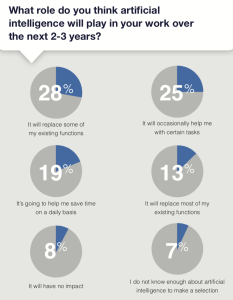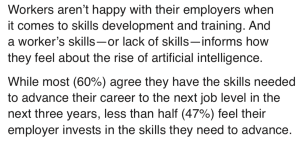As artificial intelligence (AI) technology continues to advance at a rapid rate, it’s becoming increasingly obvious that the ability to harness its potential will be what becomes one of the main differentiators in the workplace.
Employers must, therefore, collaborate with their employees around AI training, to leverage its capability to streamline workplace processes.
We can see why this is so important thanks the recently published People at Work 2024 report – an ADP Research Institute (ADPRI) survey, which asked nearly 35,000 private-sector workers in 18 countries about the role they though AI will play in their work over the next few years.
What was interesting about the research was the fact a large majority said AI ‘would’ affect their jobs.
However, what was also clear was that worker’s skills —or lack of them — greatly affects how they feel about AI.
While most (60%) agree they have the skills needed to advance their career to the next job level in the next three years, less than half (47%) feel their employer invests in the skills they need to advance (see below).
Furthermore, over half (53%) lack confidence that their employer is investing in their skills development.


This makes it clear, that if the AI skills of staff are enhanced, staff will feel much better about this nascent technology.
And yet many companies are still hesitant to do this, and are instead adopting a cautious approach to AI. This may delay progress in these rapidly changing times, and put them further on the back foot.
So how can the challenge of beginning training in AI be met?
The divide in AI adoption
Let’s start with the fact that many companies’ responses to AI vary widely.
Some start with prohibiting the use of AI until they can establish clear guidelines.
Others take a more permissive stance, allowing employees to use AI tools for tasks such as drafting emails or presentations, provided no sensitive data is shared.
Between these two extremes are organizations that conduct internal pilots to explore AI’s potential, while keeping a tight rein on its application.
But this cautious approach, while perfectly understandable, may need to be re-considered in some situations.
Employees, eager to improve their efficiency, often turn to AI on their own, sometimes before understanding proper understanding or guardrails.
However, instead of this ad-hoc usage, organizations can underscore the benefits of a thoughtful and informed rollout of AI tools.
Bridging the gap between AI and everyday work
A big focus when integrating AI into the workplace is bridging the gap between recreational and professional use.
Many people first encounter AI at home, perhaps through the news, a child’s homework, word of mouth or even casual experimentation.
This familiarity should be leveraged to ease AI’s transition into the workplace.
But, to help ground AI in a professional context, it’s essential to provide clear examples of its practical applications and benefits.
For instance, HR professionals could use AI to streamline recruitment processes, write job descriptions, provide intelligent employee self-service and improve employee engagement strategies
By framing AI as a tool that can make daily tasks more efficient and less cumbersome, companies can help employees see its value beyond any preconceived notions.
AI literacy for all employees
AI literacy should not be confined to any one department.
Every team, from sales, finance, marketing to customer service, can benefit from understanding AI’s potential.
Encouraging non-technical employees to participate in AI discussions and brainstorming sessions can lead to unexpected and innovative applications of the technology.
We know people are already using AI tools in a variety of ways, either in their day-to-day work or at home. Developers, for instance, use it to refine their projects. Others may use it to enhance presentations, because AI’s ability to distill complex information into concise, impactful slides has proven invaluable.
It’s also a powerful tool for doing quick research. Before getting any kind of training, many employees are left to figure things out on their own, which can lead to inconsistent and sometimes risky practices.
To address this, some companies offer internal training courses, educating their workforce on the organizations guidelines, guardrails, and foundational position on the use of AI.
From there, some also encourage employees to take courses from approved and credible third-party education providers.
This approach ensures staff are well-versed in foundational AI concepts while fostering a deeper understanding and more effective use of the technology.
It’s worth remembering that not all learning needs to be formal training.
For example, team members can share their AI projects and outcomes at regular meetings, providing tips and ideas for other employees.
What could be useful, however, is that every unit could have area experts – someone who delves into how AI can be best leveraged to drive more value in their department.
These sessions, combined with resources like an AI Community of Practice, where the latest research and developments are shared, can foster a culture of innovation and collaboration.
Continuous learning and adaptation
Empowering employees with AI knowledge is not just about offering courses; it’s about creating an environment that promotes continuous learning and adaptation.
The rapid pace of AI development necessitates this.
Keeping up with these changes requires a proactive approach to education and training.
Regular refreshers and updates ensure employees are always equipped with the latest knowledge and best practices.
Micro-learning can be particularly effective in this context.
Short, focused training sessions that are easily digestible can help employees stay up to date without overwhelming them.
These sessions can be delivered through various channels, such as company intranet sites or video snippets, making learning accessible and convenient.
Talent retention
Everyone knows that in a competitive labor market, one of the best ways to retain valued employees is to enhance their skills. Employees want to be relevant and useful.
Fortunately, good employers agree on the importance of learning and development, according to recent data from ADP’s Market Pulse survey of over 1,500 business leaders and HR decision makers.
Across all business sizes, all ranked “learning and development/employee training program” as one of the most important things to offer employees to both attract and retain them.
Whether you call it re-skilling or up-skilling or just plain training, employers today must keep their staff up to date on the latest technology.
AI holds tremendous potential to transform the workplace, but its successful integration requires a thoughtful and strategic approach.
Companies must move beyond fear and hesitation, embracing AI as a tool that can enhance efficiency and innovation.
By providing structured training, fostering a culture of continuous learning, and promoting ethical use, organizations can empower their employees to leverage AI effectively.
Ultimately, those who adapt and harness the power of AI will be better positioned to thrive in the evolving job market.
